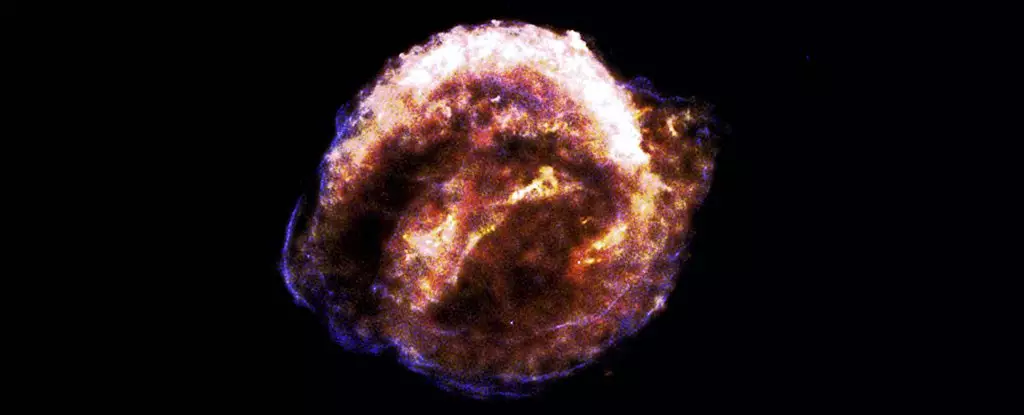In the grand theater of the cosmos, the death throes of massive stars manifest as supernovae—an astronomical event that releases staggering amounts of energy and material into the universe. These cataclysmic explosions are not merely spectacular displays of nature’s power; they serve a critical role in the galactic ecosystem by synthesizing and dispersing heavy elements like iron into the interstellar medium. This phenomenon has profound implications for life on Earth, particularly through the isotopic signatures left in geological records, including the ancient seafloor sediments that hold remnants from supernova explosions that occurred between two to six million years ago.
Recent research published in the *Astrophysical Journal Letters* provides a comprehensive study of supernovae and their energetic impact on Earth. Lead author Caitlyn Nojiri and her team delve into how stellar deaths influence our planet’s environment and biological history, revealing a symbiotic relationship between cosmic events and the evolution of life on Earth. This endeavor highlights the essence of unraveling the implications of these cosmic catastrophes not only for the elemental composition of Earth but also for the biological corridors of life itself.
Cosmic radiation—a consistent and pervasive aspect of Earth’s environment—plays a significant role in the biological processes occurring on our planet. Research indicates that Earth’s exposure to ionizing radiation from both terrestrial sources and cosmic origins is a constant presence, with varying intensities dependent on cosmic events, including nearby supernova explosions. These variations can enhance radiation levels by several orders of magnitude, potentially influencing the course of natural selection by altering mutation rates.
As the study elucidates, two key layers of Fe60 isotopes in ancient sedimentary deposits are indicative of supernova influence. The authors suggest that these accumulations stem from separate events. One is directly linked to a supernova explosion, while the older layer marks Earth’s transition into the so-called Local Bubble—a region sculpted by the stellar winds and remnants of massive stars, which expanded their influence over millions of years. The intricacies of these isotopic records lend credence to the idea that cosmic events serve as catalysts in shaping biological evolution through radiation-induced mutations.
The inquiry into radiation’s role extends beyond mere exposure; it raises questions about the biological effects such levels of energy might have had on early life forms. The researchers speculate on the potential for radiation to inflict double-strand breaks in DNA—a form of nuclear damage with the capacity for severe repercussions, including mutations and chromosomal aberrations. However, as alarming as potential DNA damage might be, the researchers also posit an intriguing perspective: this very damage may have fostered biological diversification through increased mutation rates, acting as a pivotal mechanism in the evolutionary transition of life.
The study references past research indicating a surge in viral diversification rates coinciding with the period of increased cosmic radiation. Such correlations beg additional investigation into whether supernovae radiation could serve as a trigger for evolutionary advancements, suggesting that these cosmic explosions—while destructive in nature—may have inadvertently paved the way for biological complexity on Earth.
Nevertheless, the effects of radiation on biology are complex and multifaceted. The research presented raises critical questions about thresholds where radiation shifts from being a potential catalyst for life to a harmful agent. The nuances of cosmic radiation involve a spectrum of interactions that are not yet fully understood, particularly when considering the types of radiation present at different altitudes and their relative impacts.
The researchers acknowledge that current knowledge on cosmic radiation, particularly muons, remains inadequate. Further exploration is paramount to define the biological thresholds that determine when radiation can foster beneficial mutations or become detrimental to organisms. Such insights could illuminate our understanding of evolutionary biology and the adaptive strategies organisms may deploy in response to rapid environmental changes.
The intricate relationship between supernovae and the evolution of life on Earth presents an awe-inspiring narrative of cosmic interconnectivity. As we continue to probe the depths of the universe and unravel the mysteries of high-energy astrophysical phenomena, it becomes increasingly clear that these cosmic events are not merely distant occurrences; they have profound implications for the origins and evolution of the intricate tapestry of life on Earth.
Supernovae, with their profound influence, provides a fascinating lens through which scientists can analyze the evolution of life, revealing avenues for further research into the biological implications of cosmic environments. The awareness of our cosmic connections reminds us that our very existence is intricately woven into the fabric of stellar history—an ongoing evolution shaped by the explosive births and deaths of stars that illuminate our night sky.

